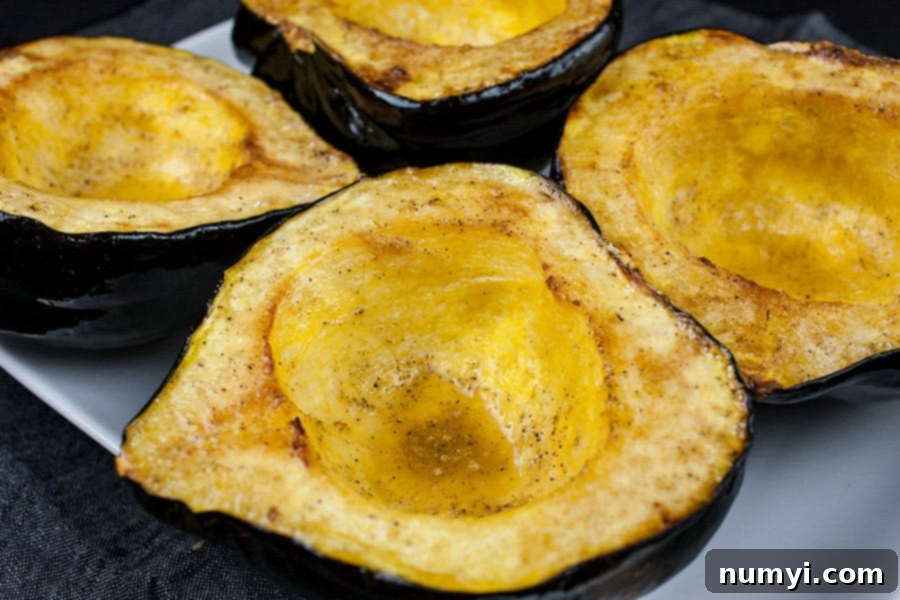Perfectly Roasted Acorn Squash: An Easy & Healthy Winter Side Dish Recipe
Roasted acorn squash halves are an absolute delight, offering a comforting and flavorful addition to any winter meal. With its distinctive slightly sweet and nutty profile, acorn squash readily embraces a variety of seasonings, making it incredibly versatile. This simple yet elegant side dish is not just delicious but also packed with nutrients, making it a fantastic choice for family dinners, holiday feasts, or even a light, healthy meal on its own.
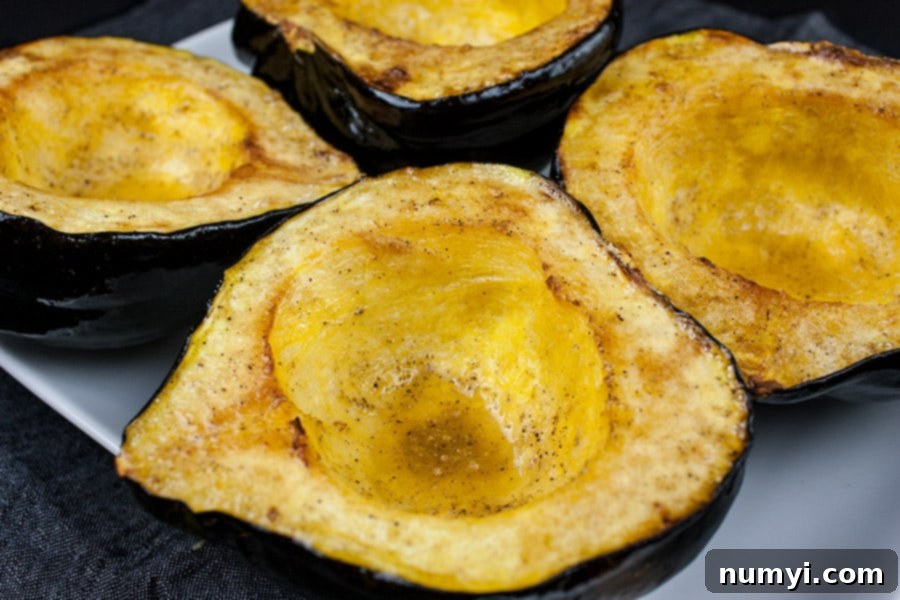
Why You’ll Love This Roasted Acorn Squash Recipe
There are countless reasons why roasted acorn squash deserves a prominent place on your table this season. Whether you’re planning a grand Thanksgiving dinner, a festive Christmas spread, or simply seeking a wholesome and delicious side for any weeknight, this recipe delivers on all fronts.
- Effortlessly Simple: Despite its impressive appearance, this dish is remarkably easy to prepare. With just a few basic ingredients and straightforward steps, even novice cooks can achieve perfect results.
- Naturally Delicious Flavor: Acorn squash boasts a unique blend of sweetness and earthy nuttiness that deepens and caramelizes beautifully during roasting. It’s a comforting flavor that complements a wide array of main courses.
- Hearty and Satisfying: Unlike some lighter vegetable sides, roasted acorn squash is wonderfully substantial. It adds a satisfying texture and rich flavor to your meal, helping to make it feel complete and well-rounded.
- Minimal Ingredients: This roasted acorn squash recipe requires only four core ingredients – the squash itself, butter, salt, and pepper – allowing its natural flavors to shine. This simplicity also means less time spent shopping and more time enjoying your meal.
- Versatile Pairing: It pairs beautifully with various proteins and other side dishes. We especially love serving it alongside our fast mashed potatoes, rich baked macaroni and cheese, and vibrant roasted green beans and mushrooms for a truly memorable meal.
What is Acorn Squash?
Acorn squash, scientifically known as Cucurbita pepo, is a fascinating member of the squash family, often going by the names pepper squash or Des Moines squash. Despite being categorized as a “winter squash” due to its hard rind and longer storage capabilities, it actually belongs to the same species as many summer squashes. Its distinct acorn-like shape gives it its name, and it typically features a dark green exterior with occasional patches of orange or yellow, and a bright, sweet, yellow-orange flesh inside.
Beyond its appealing flavor and appearance, acorn squash is a nutritional powerhouse. It’s an excellent source of dietary fiber, which aids in digestion and promotes a feeling of fullness. It’s particularly rich in Vitamin C, a powerful antioxidant vital for immune system function and skin health. Additionally, it provides a good amount of Vitamin A (in the form of beta-carotene, giving it its vibrant color), B vitamins (like folate), and essential minerals such as potassium, manganese, and magnesium. These nutrients contribute to overall well-being, support healthy vision, and help protect the body against cellular damage.
How to Pick the Best Acorn Squash
Choosing the right acorn squash is key to ensuring the best flavor and texture for your roasted dish. Here’s what to look for when selecting your squash:
- Color Balance: Opt for a squash with a balanced mix of dark green and some orange or yellow spots. If it’s too uniformly green, it might be underripe, resulting in less sweetness. If it’s overly orange, it could be past its prime and have a stringier, drier texture.
- Smooth Skin: The skin should be firm and smooth to the touch, without any soft spots, wrinkles, or blemishes. Minor imperfections are usually fine, but avoid any squash with significant cuts or mold.
- Weight for Size: Pick up several squashes of similar size. A heavier squash for its size indicates more moisture and denser flesh, which translates to better flavor and texture after roasting.
- Stem: A dry, firm stem is a good sign of ripeness and proper harvesting. Avoid squashes with missing or soft stems.
How to Safely Cut Acorn Squash
Cutting acorn squash can seem daunting due to its hard rind, but with the right technique and a focus on safety, it’s quite simple:
- Gather Your Tools: You’ll need a very sharp, heavy-duty chef’s knife and a sturdy, non-slip cutting board. A damp paper towel placed under your cutting board can help prevent slipping.
- Stabilize the Squash: Place the acorn squash horizontally on your cutting board. If it’s wobbly, you can carefully slice a tiny bit off the bottom to create a flat, stable surface, ensuring it doesn’t roll while you’re cutting.
- Careful Cut: Using your sharp knife, carefully cut the squash in half from stem to tip. This can require a bit of force. Be extremely cautious during this step, as the squash can sometimes rock, increasing the risk of the knife slipping. A helpful trick many home cooks use for extra stubborn squashes is to gently tap the back of the knife blade with a rubber mallet, pushing it through the squash without putting excessive pressure on the cutting hand.
- Scoop Out Seeds: Once halved, use a sturdy spoon (an ice cream scoop works wonders!) to scrape out the seeds and any stringy pulp from the inside of each half until the cavity is clean. You can discard the seeds or save them for roasting later for a delicious snack.
How to Make Perfectly Roasted Acorn Squash
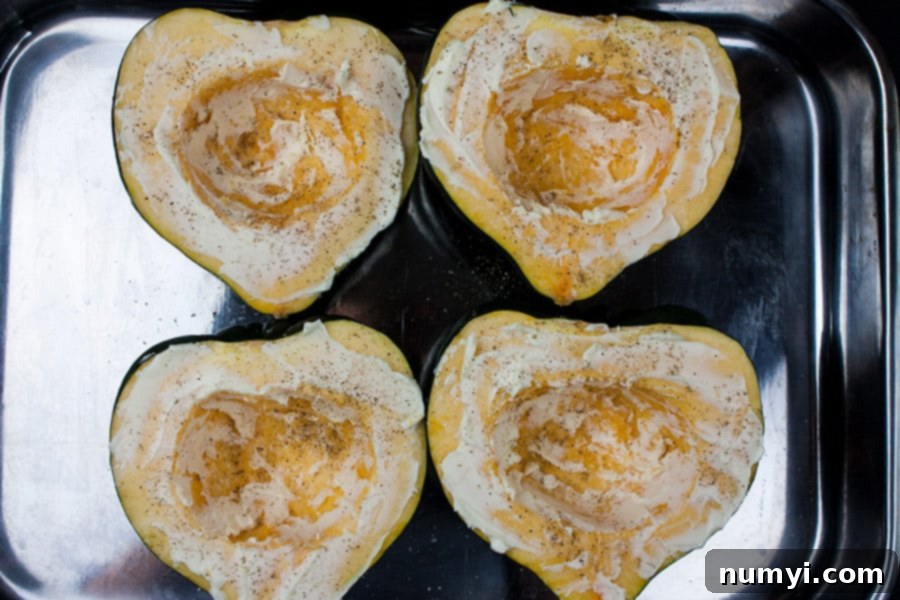
This recipe is incredibly straightforward, resulting in tender, caramelized acorn squash every time. Follow these simple steps for a truly delicious side dish:
- Preheat Your Oven: Begin by preheating your oven to 425ºF (220ºC). This high temperature is crucial for achieving that beautiful caramelization and tender texture.
- Prepare the Squash: With your acorn squash cut in half and seeds scooped out (as per the “How to Cut Acorn Squash” section), you have a couple of options for preparing the flesh. You can optionally score the flesh in a cross-hatch pattern with your knife. This isn’t strictly necessary for cooking but can help the butter and seasonings penetrate deeper into the squash, enhancing its flavor and making it even more fork-tender.
- Butter and Season: Take one tablespoon of softened unsalted butter and generously rub it over the inside flesh of each acorn squash half. The butter adds richness and helps with browning. Then, sprinkle evenly with kosher salt and freshly ground black pepper. Feel free to be generous with the seasoning – it enhances the natural sweetness.
- Prepare for Roasting: Place the seasoned acorn squash halves cut-side up (flesh-side facing up) in a large roasting pan. Crucially, fill the bottom of the roasting pan with about 1/4-inch of water. This creates a steamy environment in the oven, which helps the squash cook evenly, keeps it from drying out, and prevents the bottom from scorching, resulting in a perfectly moist and tender interior.
- Bake to Perfection: Transfer the roasting pan to your preheated oven and bake for approximately 1 hour to 1 hour and 15 minutes. The exact time may vary depending on the size of your squash and your oven. You’ll know it’s ready when the flesh is beautifully browned around the edges, deeply colored, and easily pierced with a fork (fork-tender). The water in the pan might evaporate during this time, which is normal.
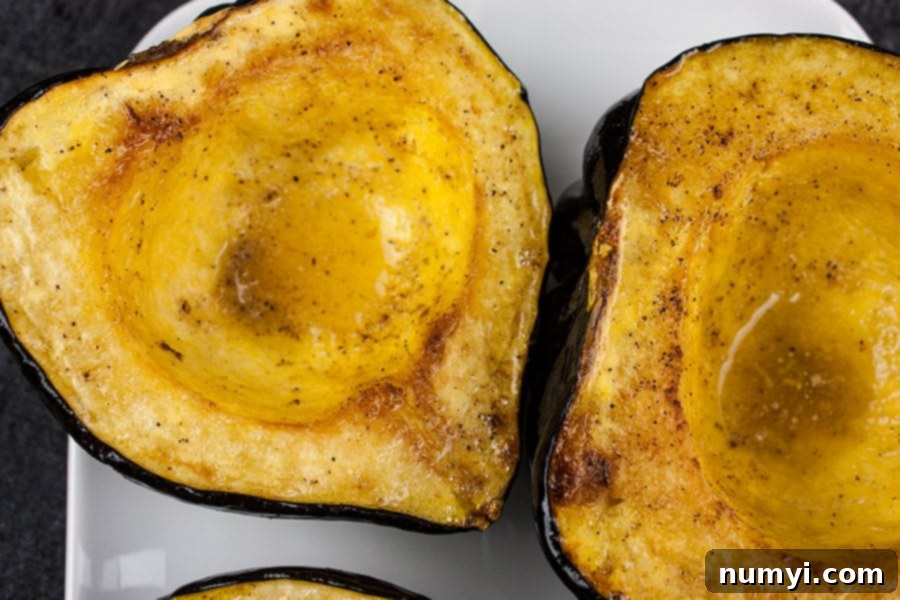
Once baked, carefully remove the roasting pan from the oven. Let the squash cool for a few minutes before serving. You can either scoop out the tender, cooked flesh and serve it in a bowl, or present it elegantly in its naturally beautiful shell, allowing guests to scoop out their own portions.
Roasted Acorn Squash Serving Suggestions
This versatile roasted acorn squash can be served in many ways, making it a perfect complement to various meals:
- Classic Main Course Pairing: Serve the roasted halves as a wholesome side with your favorite proteins like succulent roasted pork loin, tender baked chicken, a traditional holiday turkey, or a hearty beef roast. Its sweetness and richness cut through savory meats beautifully.
- Hearty Vegetarian Meal: For a fulfilling meatless meal, pair roasted acorn squash with a robust grain such as nutty farro, protein-packed quinoa, or fluffy steamed rice. You can further elevate this by tossing in other roasted vegetables like crispy Brussels sprouts or vibrant broccoli florets. Add a drizzle of balsamic glaze for an extra pop of flavor.
- Stuffing Option: The hollowed-out halves make excellent vessels for stuffing! Fill them with a savory mixture of cooked grains, herbs, crumbled sausage (or vegetarian sausage), onions, and perhaps some dried cranberries or nuts before or after roasting.
- Salad Topper: Once roasted and cooled slightly, scoop out the flesh and dice it. Add these flavorful cubes to your favorite winter salads for an added layer of sweetness, texture, and nutrition.
Expert Tips for Perfect Roasted Acorn Squash
Achieving perfectly roasted acorn squash is simple, but a few expert tips can elevate your dish:
- Choose the Right Roasting Pan: Always use a roasting pan with high sides. This is crucial because the 1/4-inch of water added to the bottom of the pan creates steam, preventing the squash from drying out and scorching. A shallow sheet pan won’t hold the water effectively, leading to a drier result.
- Even Slicing: Try to cut your acorn squash halves as evenly as possible. This ensures that both halves cook at the same rate and become tender simultaneously.
- Don’t Overcrowd: If you’re roasting multiple squashes, make sure they have enough space in the pan. Overcrowding can lead to steaming instead of roasting, preventing the beautiful caramelization. Use two pans if necessary.
- Soften Butter Ahead: Ensure your butter is softened to room temperature. This makes it much easier to rub evenly over the squash flesh.
- Customize Seasoning: While salt and pepper are essential, don’t hesitate to experiment with other spices (see variations below) to match your meal.
Delicious Variations to Try
While the classic butter, salt, and pepper method is fantastic, acorn squash is incredibly versatile and lends itself beautifully to various flavor enhancements:
- Sweet Delights: For a sweeter profile, replace the salt and pepper with a generous sprinkle of brown sugar over each half before roasting. For an even more decadent treat, drizzle a little maple syrup or honey over them during the last 15-20 minutes of baking. A touch of warming spices like cinnamon and nutmeg can further enhance the natural sweetness and holiday flavor.
- Savory Enhancements: Instead of butter, use a good quality olive oil for a Mediterranean twist. Add a sprinkle of garlic powder, onion powder, or fresh herbs like rosemary and thyme before roasting. A splash of balsamic vinegar or a sprinkle of cayenne pepper can add depth and a subtle kick.
- Cheesy Goodness: For an extra layer of nutty, umami flavor, sprinkle some freshly shredded Parmesan cheese over the squash during the last 10-15 minutes of roasting, allowing it to melt and slightly crisp.
- Creative Additions: Consider adding other ingredients into the cavity before roasting. Think dried cranberries, chopped pecans or walnuts, or even a spoonful of cooked wild rice for added texture and flavor.
- Incorporating into Other Dishes: Roasted acorn squash isn’t just a side dish! Once cooked and cooled, the tender flesh can be added to casseroles, used as a base for creamy soups, blended into chili for added richness, or folded into salads, cooked beans, or rice dishes for an autumnal touch.
Frequently Asked Questions About Roasted Acorn Squash
Roasted acorn squash is an excellent candidate for make-ahead meal prep. You can bake the squash up to 2 days in advance. Once cooled, wrap each piece tightly in aluminum foil and store it in an airtight container in the refrigerator. To reheat, place the foil-wrapped squash in an oven preheated to 400°F (200°C) and bake until just heated through, typically about 15-20 minutes, or until warmed to your liking.
Look for a squash that has a good balance of dark green and some orange or yellow coloring. If it’s too green, it may not be fully ripe and could lack sweetness. If it’s too orange, it might be overripe and stringy. The skin should be smooth and firm, free from any soft spots, wrinkles, or blemishes. Lastly, choose a squash that feels heavy for its size, indicating dense flesh and good moisture content.
Yes, absolutely! When acorn squash is roasted, especially at the recommended temperature, its skin becomes surprisingly soft and tender, making it perfectly edible. Many people enjoy the added texture and nutrients the skin provides. However, if the skin texture isn’t to your preference, it’s easy to scoop out the soft flesh and discard the skin.
Allow any leftover roasted acorn squash to cool completely to room temperature. Then, transfer the halves (or scooped-out flesh) into an airtight container and refrigerate for up to 4 days. To reheat, you can either wrap or cover it in aluminum foil and warm it in an oven at 400°F (200°C) until heated through, or simply reheat individual portions in the microwave for 1-2 minutes (without foil, of course).
Yes, both raw and cooked acorn squash can be frozen.
For uncooked acorn squash: You’ll need to remove the skin and cut the squash into smaller chunks or cubes. For best results, flash-freeze the pieces by spreading them in a single layer on a parchment-lined baking sheet until hard. Once frozen, transfer them to a freezer-safe bag or container and freeze for up to 2 months. Keep in mind that raw squash may not retain its perfect texture as well as cooked squash after thawing.
For roasted acorn squash: You can remove the cooked flesh from the skin in chunks or mash it up. Place the cooked squash in a freezer-safe airtight container or heavy-duty freezer bag, removing as much air as possible. It can be frozen for up to 6 months. To use, thaw overnight in the refrigerator before reheating.
More Delicious Side Dish Recipes
Easy Pecan Roasted Sweet Potato Casserole
Horseradish Sour Cream Roasted Asparagus
Fresh Green Bean Casserole From Scratch (no soup)
Are you on Pinterest? Click the button below to add this recipe to one of your boards!
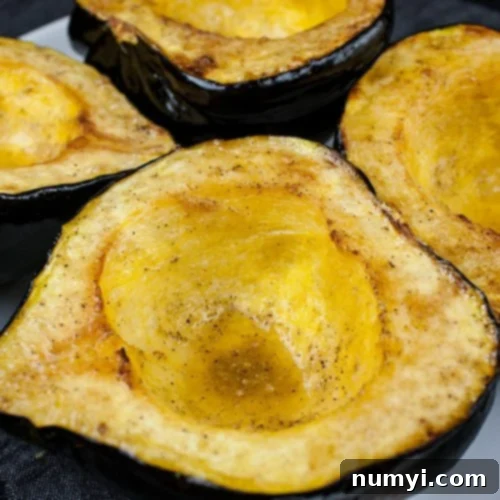
Classic Roasted Acorn Squash Halves
Print
Pin
Rate
Side, Side Dish, Vegetable
American, Seasonal
5 minutes
1 hour
15 minutes
1 hour
20 minutes
4
186
kcal
Leigh Harris
Ingredients
-
2
Acorn Squash
-
4
tablespoons
unsalted butter,
softened to room temperature
-
1/2
teaspoon
kosher salt
-
1/4
teaspoon
black pepper
freshly ground for best flavor
Metric
Instructions
-
Preheat your oven to 425ºF (220ºC).
-
Carefully cut each acorn squash in half from stem to tip using a large, sharp knife and a non-slip cutting board. Be very cautious, as the squash can be hard to cut and may cause the knife to slip. For stubborn squashes, you can gently tap the back of the knife with a rubber mallet.2 Acorn Squash
-
Using a sturdy spoon, scrape out all the seeds and stringy pulp from the inside of each squash half until clean. If desired, you can lightly score the flesh in a cross-hatch pattern to help it absorb more flavor, though this step is optional.
-
Generously rub 1 tablespoon of softened unsalted butter over the inside flesh of each acorn squash half. Season evenly with kosher salt and freshly ground black pepper.4 tablespoons unsalted butter,,
1/2 teaspoon kosher salt,
1/4 teaspoon black pepper -
Place the seasoned acorn squash halves cut-side up (flesh-side) in a large roasting pan. Pour approximately 1/4-inch of water into the bottom of the pan. This step is key to keeping the squash moist and preventing it from drying out or scorching during roasting.
-
Bake for 1 hour to 1 hour and 15 minutes, or until the flesh is tender when pierced with a fork and slightly browned around the edges. Remove from oven and let cool slightly before serving.
Notes
Storing Leftovers: Allow any leftover roasted squash to cool to room temperature. Place them in an airtight container and refrigerate for up to 4 days. Reheat wrapped in aluminum foil in the oven, or quickly in the microwave.
Freezing Uncooked Squash: To freeze raw acorn squash, first peel it and cut it into smaller chunks or cubes. Flash-freeze the pieces on a parchment-lined baking sheet until solid, then transfer to a freezer-safe bag or container. Store for up to 2 months. Note that raw squash can become slightly softer after thawing compared to cooked squash.
Freezing Cooked Squash: To freeze roasted acorn squash, you can either scoop the cooked flesh from the skin in chunks or mash it. Place it in a freezer-safe airtight container or bag and freeze for up to 6 months. Thaw overnight in the refrigerator before reheating or using in other recipes.
Nutrition
Serving:
4
g
|
Calories:
186
kcal
|
Carbohydrates:
22
g
|
Protein:
1
g
|
Fat:
11
g
|
Saturated Fat:
7
g
|
Cholesterol:
30
mg
|
Sodium:
298
mg
|
Potassium:
747
mg
|
Fiber:
3
g
|
Vitamin A:
1140
IU
|
Vitamin C:
23.7
mg
|
Calcium:
74
mg
|
Iron:
1.5
mg
